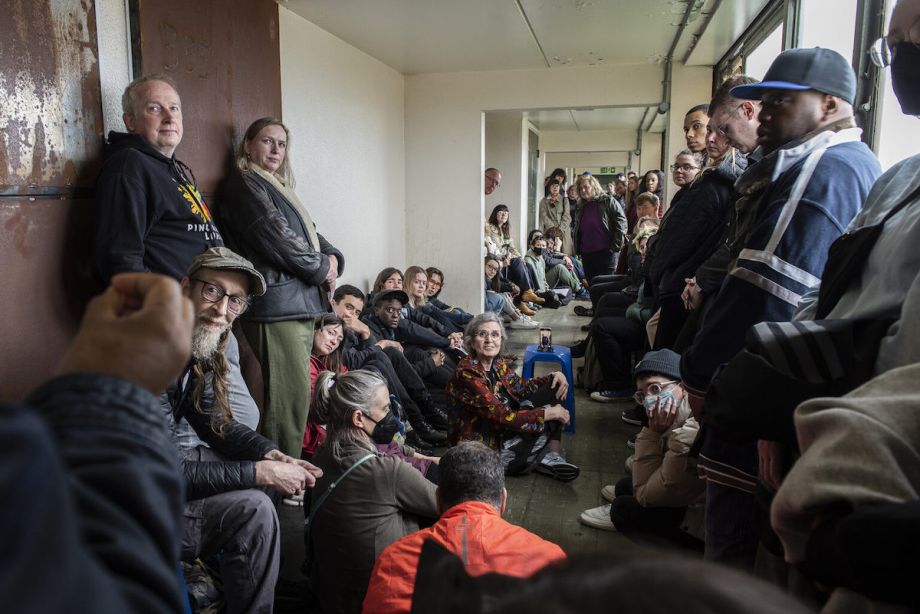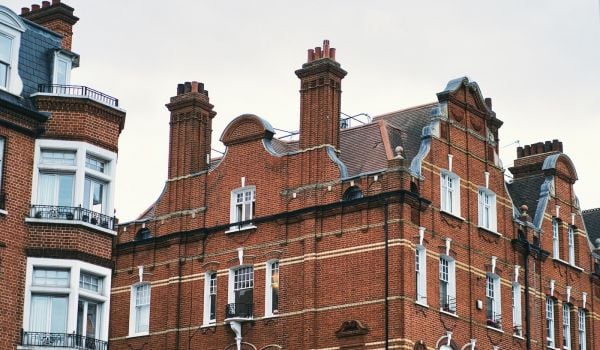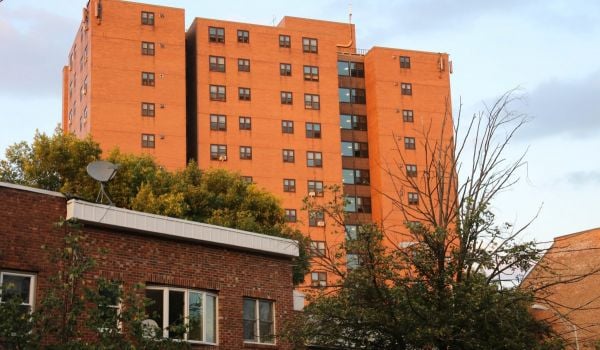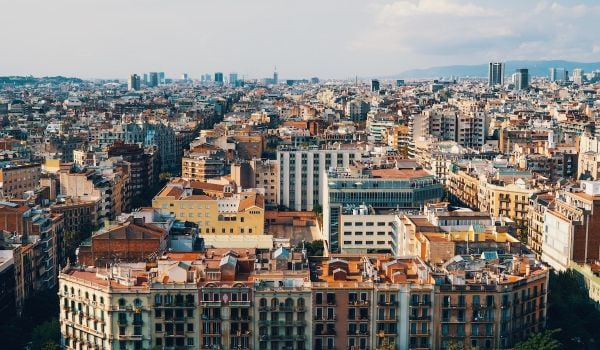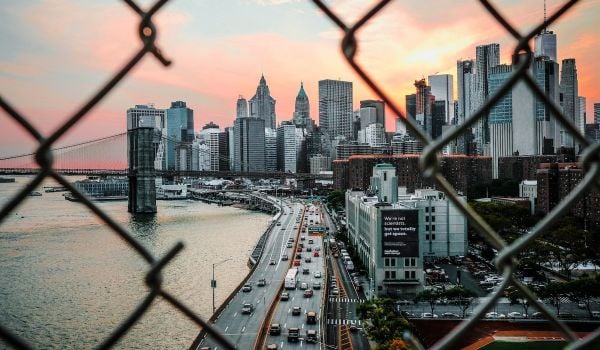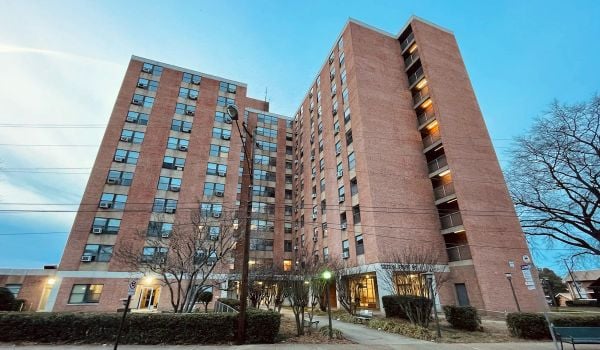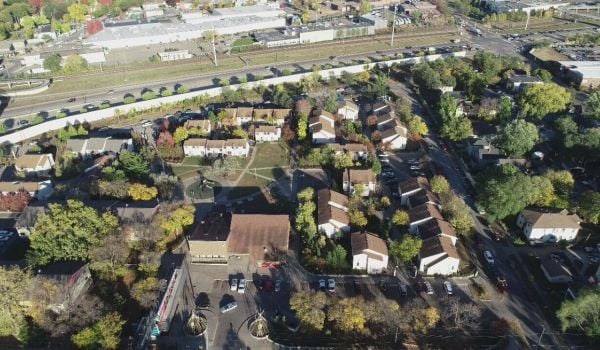This article was originally published on Waging Nonviolence.
London’s residents face the highest rents and have the lowest rate of homeownership in the U.K. today. One solution would be for local councils to expand public housing, known as “council housing.” However, the waitlist for these homes has jumped by 50,000 since 2020. This has happened partially because London councils have reduced their housing stock by 10 percent since the beginning of the pandemic, often due to privatization.
Building complexes made up of only council housing, called council estates, are becoming increasingly rare sights in the capitol. In April, I visited the “Fight for Aylesbury” exhibit, a history and rallying cry for the Aylesbury Estate, often called the largest public housing complex in Europe. Once home to roughly 7,500 people, it has now been mostly vacated to prepare for its demolition this summer, and currently houses only 30. Its residents have been fighting to stop its demolition for more than 20 years. Aysen Dennis hosted the exhibit in her own home within the estate. Open to all, the show flipped Aysen’s private and public life inside out, showcasing the actions that have kept the Aylesbury public (and standing) since it was first threatened with demolition in 2001.
Tucked in the heart of the “up and coming” neighborhood of Elephant and Castle, the Aylesbury Estate is a huge cluster of concrete blocks, with courtyards nestled in between. It makes up part of Southwark Borough. Demolition plans would replace 327 council homes with 614 new units, only 163 of which would be priced at affordable rent rates. This doesn’t include more than 100 homes that have already been purchased by former council renters that are also now slated to be demolished.
In 1997 Tony Blair used the then 20-year-old estate as backdrop for his inaugural speech as prime minister. Blair described Aylesbury’s residents as “forgotten people,” with no hope or prospects, depicting the estate as a run-down failure. His promises were that his government would “regenerate” the Aylesbury (a term for urban renewal that often means demolition) and places like it. In 1999, Southwark council began attempts to privatize the Aylesbury, and soon demolition plans were on the table.
To get to the exhibit I followed a series of paper arrows snaking along one of the taller blocks. Eight flights of cold, damp stairs took me down a cold hallway, lined by vacant apartments that have been shut. Aysen’s door is unwelded and propped open. The apartment was warm, full of people, and clearly deeply lived in. Postered were plastered to the wall and even covered the ceiling in the hallway, ranging from DIY placards to legal documents. The poster right next to the door read: “Welcome to my home. I am opening the doors to my flat for a collective celebration of 20+ years of housing struggles to defend our council homes against social cleansing and gentrification. Our fight is ongoing.”
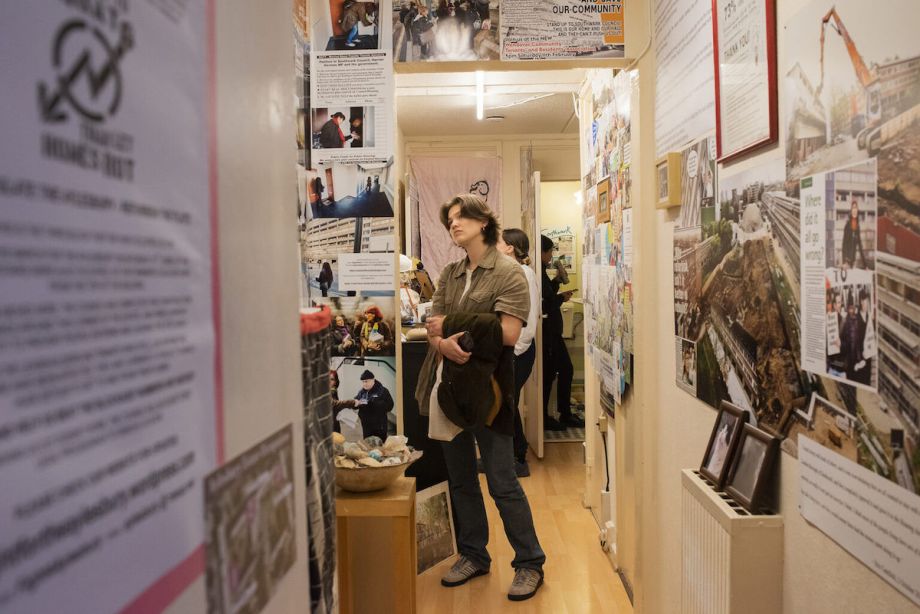
A visitor reads pamphlets in Aysen’s hallway during the exhibit. (Waging Nonviolence / Alessia Gammarota)
The Aylesbury estate has long had a reputation as a hub of gang violence and criminal activity. Some former residents say that the estate often was dangerous, but many, Aysen among them, maintain it was a safe and thriving community before demolitions began. Sixty-eight percent of the Aylesbury’s residents were from Black or ethnic minority backgrounds (compared to 48 percent in the borough) — a fact that’s been compounded with racism to warp the day-to-day reality of the estate. For example, the Aylesbury’s “gangs” were often just groups of Black teenagers. Historian Michael Romyn, whose research featured throughout the show, deduces that “it is likely that levels of recorded crime on the Aylesbury were roughly comparable with the surrounding area and inner London generally.”
Historically Black neighborhoods in South London have long been subject to such discrimination. Jason De Souza, an activist and journalist attending the exhibit, described to me how interviewers used to reject his mother for work due to her Brixton post-code when he was growing up. “They had images of my mom, scrambling past dead bodies and people with machine guns and rocket launchers. This whole classist and racist lens of what Brixton was.”
De Souza’s mother eventually relocated to Kent, and commuted into London for work instead. She would now be unable to afford rent in Brixton, which has become increasingly white and expensive. Former residents of the Aylesbury were also largely unable to afford rent in the neighborhood once they’d been relocated.
Warranted or not, Aylesbury’s was targeted for “regeneration,” as part of New Labour’s “Urban Task Force” inner-city renewal program. The first step was to transfer the council’s housing stock to a housing association, private non-profit organizations which take over finances and operations of low income housing blocks. They tend to charge higher rent than councils, and provide less secure tenancies.
In 2001, residents were given a chance to vote on the transfer of the housing stock. Aysen and other residents campaigned across the estate for a no vote, making sure people were informed about the possible effects. Almost 76 percent of residents showed up to the vote, and a resounding 73 percent of them voted no, choosing instead to stay a part of council housing.
As part of the exhibit, posters and news clips from this vote were displayed throughout the hallway. In between were little tchotchkes, a set of three framed photos of children that say “Auntie’s Little Angels,” lamps and candles. It was impossible to forget that you were in someone’s home.
In the years preceding the no vote, repairs, regular cleaning and other maintenance work began to slow. Maintenance requests had to be put in repeatedly and were often not responded to sufficiently. The state of disrepair that the estate came to be in would later be used as reason to demolish the estate altogether, instead of refurbish it.
In 2002, the council’s head of Housing Regeneration, Nicholas Taylor, announced that despite the no vote, the council planned to continue with plans to privatize. The council claimed that to renovate the estate would cost 200 million pounds, a sum they didn’t have. Instead, consultants were brought in to develop a “renewal strategy,” which outlined plans for the estate’s demolition and redevelopment in 2005. No input from tenants was sought this time.
Those who had banded together to inform others on the housing stock transfer began to protest the plans for demolition. This ranged from door-knocking to distributing zines and pamphlets around the estate to staging outright demonstrations outside the council’s offices. The council’s strategy up until this point had been to frame the redevelopment as “community-led,” meaning this response forced a change in tactics.
To defend the plans, the council claimed that the system-built blocks were near the end of their “anticipated life expectancy,” even though in 2015, Southwark’s in-house architect, Catherine Bates, said the “condition of the buildings does not itself present a case for demolition and redevelopment.” In this new proposal, Southwark increased the amount of private units for sale, and decreased the amount of public housing that would be replaced.
Despite various delays, the first phases of demolition started in 2010. Some 200 households living in the Arklow, Chiltern and Chartridge blocks were required to leave their flats that year, in preparation for demolition in 2015 (which was eventually pushed back to 2017). The flats left empty for those seven years were in working order. In 2022 more than 11,000 people in Southwark were on a wait-list for council housing, up almost double from 2016.
In the exhibit’s toilet, the loud noises of flushing overlaid with audio of a smacking hammer and demolition pipe out of a speaker. The room was dedicated to the councilors of Southwark — their logo is even printed onto the toilet roll. A mask depicting Peter John, Southwark’s former head of council of over a decade, is slapped on the toilet. John oversaw the demolition of thousands of council homes during his tenure, approving deals with developers. He is now employed by a company that lobbies on behalf of developers. Many Southwark councilors bear similar histories. “Doesn’t matter who comes, who goes. They call themselves, progressive, leftists, in Labour, blah, blah, blah. But at the end of the day, nothing. They all want gentrification,” Aysen said.
A shocking one in ten U.K. councilors have links to the property industry. And one in two English councils have planning practices liable to corruption, suggests research by Transparency International U.K. By transferring council housing stock to private management, or demolishing it and skimping on replacement homes (as in the case of the Aylesbury), councils continue to slowly bleed resources from the poorest people in their communities. The displacement of poor residents attracts wealthier residents, who in turn drive up the value of new developments.
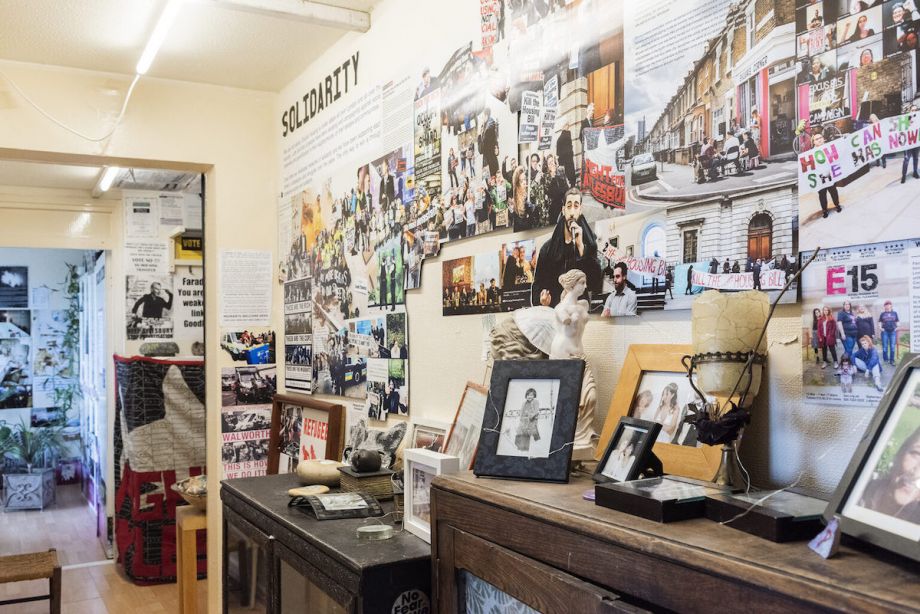
A section of Aysen’s hallway during the exhibit. (Waging Nonviolence / Alessia Gammarota)
Demolition and redevelopment also meant that council-renters who had been enabled to purchase their flats (leaseholders) were forced to sell. A pile of fat binders in the kitchen chronicled attempts to fight the demolition or to get better buy-back deals, starting in 2012. Leaseholders created a collective and contested the takeover as illegal, arguing successfully in court that the plan was in breach of basic human rights. The court’s 2016 decision to block the plan was based on the fact that many elderly residents and those from Black and ethnic minority groups were being forced to relocate (instead of being re-housed in the new development). In 2017, the council went back to court and was able to repeal the ruling. With payouts well-below market value and no local properties for sale at similar price points, many were forced out of the neighborhood.
At the start of 2015, residents re-organized to strategize about how eviction and demolition could be challenged, launching a public inquiry. Roughly 5,000 people gathered in mid-January as part of a March for Homes protest against a lack of social housing, unaffordable rent and gentrification — a large number of them residents of the Aylesbury Estate. A group of activists who had joined the protest at the estate split off and occupied three blocks that had been emptied to prepare for demolition. For three months, the squatters lived in the blocks, and both squatters and residents who were organizing held evening meetings daily.
As an attempt to stop squatters spreading further, police fenced off the estate, forcing residents to speak to security guards in order to enter or exit the building. In the beginning of April, the squatters decided to leave as the occupation became too difficult to maintain due to the guards’ aggressive actions. At the same time, a demonstration of roughly 300 people overwhelmed the guards surrounding the estate and tore the fences down.
A short film of this moment and the protest leading up to it, played on repeat in the living room during the exhibit, where guests could sit on Aysen’s couch to watch. It was a notable source of optimism, and the room was often full. Also optimistic were that many of those featured in the clip were often in the living room, helping out or stopping by to catch up.
At the far end of the living room, big windows look out onto the green courtyard, and across South London. The room was full of light. A transparent photo-print of a demolished block by Alessia Gammarota (the show’s designer) was transposed onto the glass, so you could see where it would’ve been on the skyline.
Aysen was sitting and drinking tea by the window in her armchair. “Instead of enjoying my home, I’ve been fighting to keep my home,” she told me. Photos of her and her late sister Pinar, as well as friends over the years are hung around the flat, their faces beaming. One frame features just two photos of the bathroom, newly painted and renovated by the sisters, proud of their work in their new home.
Aysen and Pinar moved to London in 1993, fleeing Turkey where they had been Kurdish activists, known as “the revolutionary sisters.” In 1999 they got their council apartment, the first long-term home either had had as adults. “I love living here,” Aysen said, “because here we are not outsiders. I feel safe, I feel I belong to this community.” Aysen’s room featured audio of poetry and speeches around her cause, and a beautiful window dedicated to mental health, dappled in imitation stained glass and wreathed in real, living flowers. People sat gingerly on her bed, listening to the audio through headphones and sniffing the blooms.
In the U.K., Aysen became involved in anarchist causes in London, whereas Pinar started a Twitter account and London network to fundraise for Kurdish prisoners and their families, distributing 60,000 pounds to Kurdish families over the years. The two lived happily in the Aylesbury flat for more than 20 years, until Pinar passed away last year.
Her room, like every other room in the apartment, is open to the public, but visitors were asked to close the door behind them when entering. Behind banners hung with stories of her life and activism is Pinar’s bed, untouched. Fifty-eight leaves are strung delicately from the ceiling, one for each year of her life. Air currents made them dance gently, and the light streaming in her window made the room glow. Aysen has heard that the room is beautiful, but she hadn’t gone inside yet — it is too difficult.
Since the “Fight for Aylesbury” exhibit has finished, Aysen has taken the developers of the estate as well as the council to high court. Media coverage paints a picture of Aysen facing the developers mostly alone and outnumbered. Yet for almost a month, Aysen’s home was full of people contributing time, money, ideas and emotional support to this cause, and this community is still intact and in contact.
With the exhibit now closed, activists have moved quickly on to preparations for the lawsuit. Many of its roughly 800 visitors have splintered off into groups, creating art, reportage and analysis around the estate and organizing further direct actions. Visitors have also taken away lessons in protecting their own homes.
It is this determination that has kept the Aylesbury standing, even though it’s been prepped for demolition since 2001. When I ask if she thinks demolition will go ahead as planned this summer, Aysen says “I don’t know, but years ago [someone] asked me, and I said, we are still here. That is the point.”
This article is part of Backyard, a newsletter exploring scalable solutions to make housing fairer, more affordable and more environmentally sustainable. Subscribe to our weekly Backyard newsletter.
Agatha Scaggiante is a U.K.-based journalist and artist. Her work explores a wide range of topics, from local and environmental journalism to digital subcultures and artwork.



